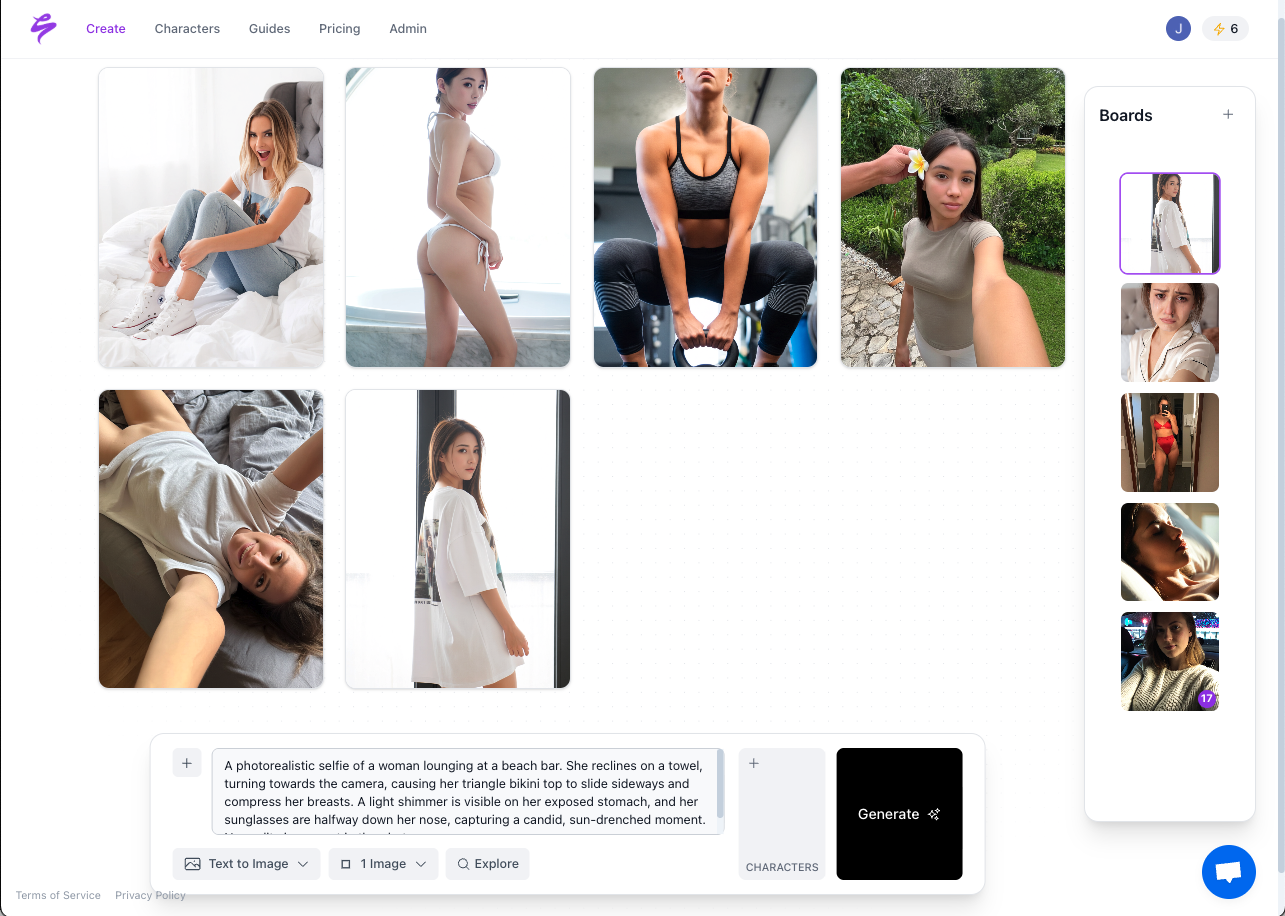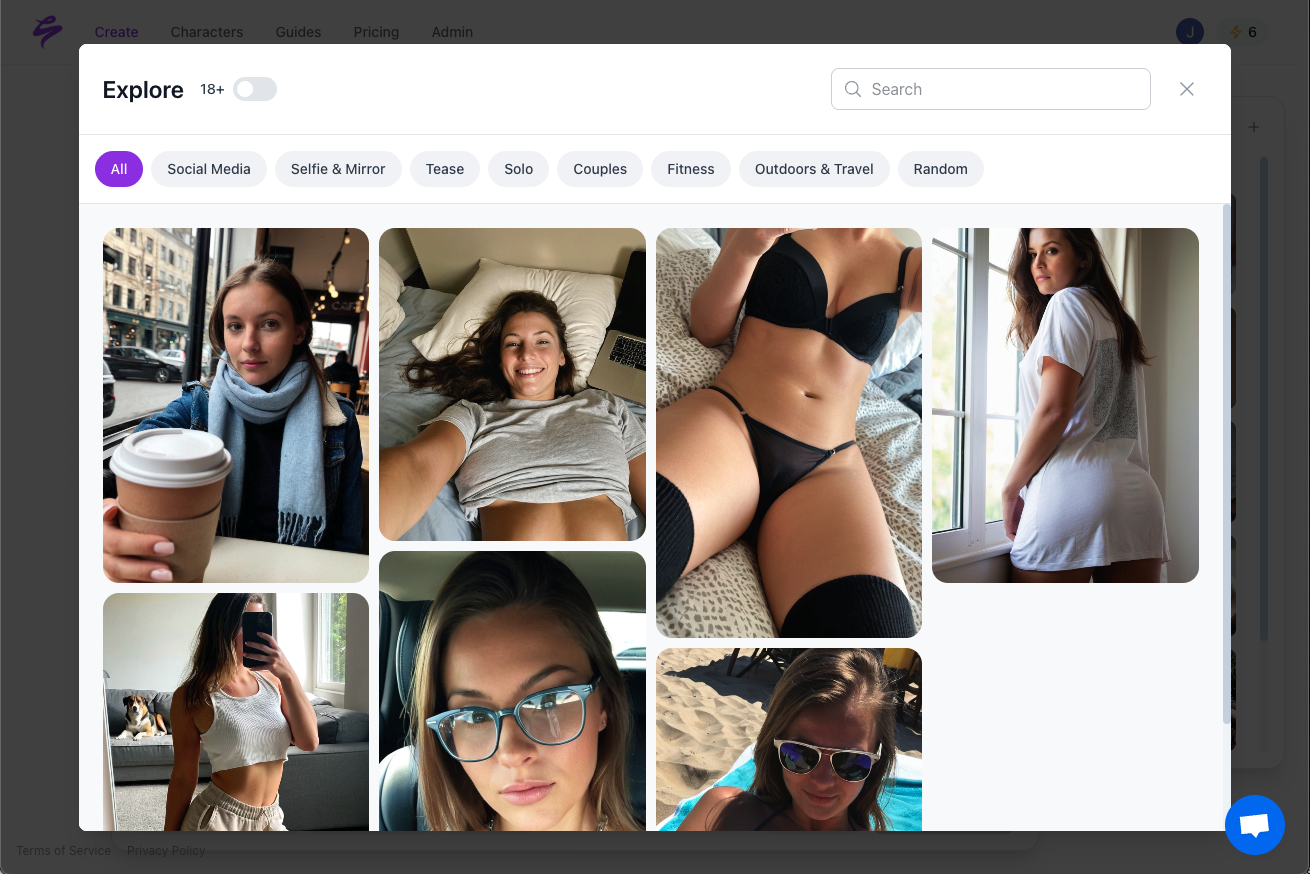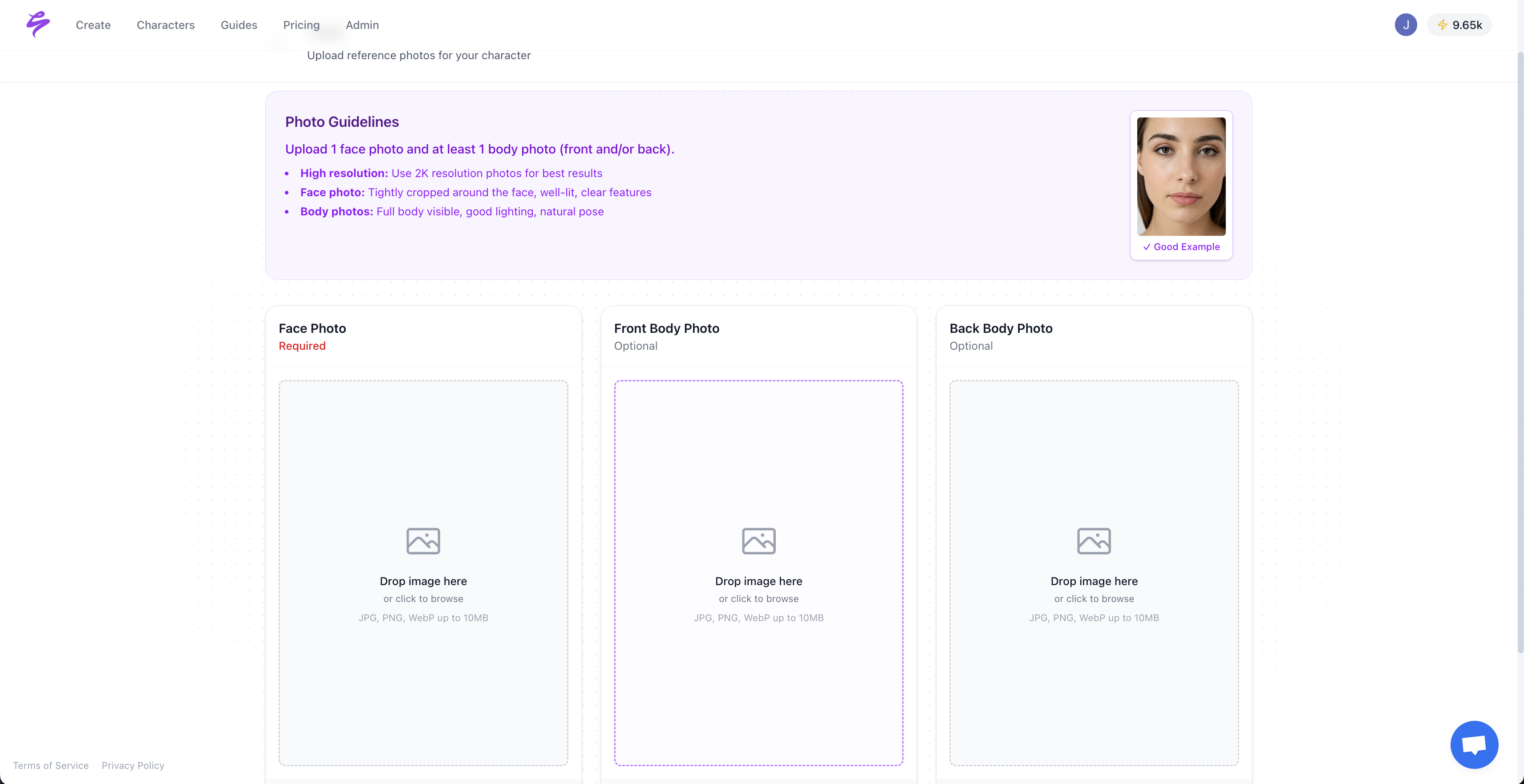Executive summary
- The creator economy relies on a constant flow of realistic content, which creates pressure, burnout, and production bottlenecks for individual creators, agencies, and virtual influencer teams.
- Pykaso offers versatile AI image and video generation across multiple styles and formats, which suits experimental artists and broad marketing use cases that do not depend on a single consistent persona.
- Sozee is built specifically for monetizing creators, with instant likeness capture from as few as three photos, hyper-realistic output, and workflows that support SFW and NSFW funnels, agencies, and virtual influencer projects.
- Sozee generally fits creators, agencies, and virtual influencer builders who prioritize revenue-focused workflows, fast setup, and likeness privacy, while Pykaso fits users who value stylistic range and deeper technical control.
- Key decision factors include setup time, realism standards, character consistency, privacy guarantees, agency and team features, and how well each platform integrates with existing creator business workflows.
How Realistic AI Content Platforms Address The Creator Content Crisis
The modern creator economy runs on a simple equation: more content usually leads to more traffic, sales, and revenue. Human limits prevent creators from matching fan demand, which can exceed their production capacity by an estimated 100 to 1. Many in the industry describe this gap as the Content Crisis.
This crisis shows up in several parts of the ecosystem. Individual creators face burnout as they try to post frequently while staying authentic and on brand. Agencies managing multiple creators risk missed deadlines and lost revenue when talent becomes unavailable or slows production. Virtual influencer builders often spend months fixing consistency issues while social media trends move on.
Realistic AI content generation platforms aim to reduce this pressure by breaking the link between a creator’s physical availability and their ability to publish. Realism is essential in this context. For content on OnlyFans, Instagram, TikTok, or in brand partnerships to earn revenue, it needs to look like it came from real cameras and real shoots. Fans usually recognize artificial or distorted visuals, which can reduce engagement and conversions.
The value of these platforms goes beyond volume. Effective tools maintain consistent character appearance, align with the creator’s brand, and meet clear quality standards, while still preserving the sense of authenticity that drives fan relationships. Agencies need predictable content pipelines and reliable revenue. Individual creators need time back for strategy and personal well-being without sacrificing income.
Different AI content tools serve very different purposes. Some focus on general art or broad marketing visuals. Others are designed around the specific demands of monetizing creators, agencies, and virtual influencer teams. Clear understanding of these differences helps you pick a platform that matches your goals and working style.
Many creators want to scale content without losing authenticity. Learn how Sozee can increase your creative output while maintaining your brand.
Pykaso’s Capabilities for Realistic AI Content Generation
Pykaso positions itself as a broad AI content platform that supports both image and video generation. The platform offers image-to-image and text-to-image workflows that can copy style, pose, angle, and lighting with minimal prompting. This flexibility appeals to a wide set of users, including content creators and marketing teams that need varied visual assets.
Technical features form a major part of Pykaso’s value. The platform supports 4K AI video generation from images, upscaling tools, face swaps, and character-focused creation for viral-style content. This toolkit allows users to create, refine, and improve content across several iterations, which provides fine control over the final result.
Character consistency relies heavily on LoRa (Low-Rank Adaptation) models within Pykaso. Users train LoRa models for their AI influencers or characters, which can improve consistency and customization compared to standard text prompts. This method offers strong control once set up, but it demands time, data, and attention from users during the training and configuration phase.
Pykaso also extends into animation. The AI animation generator turns images into short clips, usually between 5 and 10 seconds, using text prompts or direct image input. Users can select from several models, adjust aspect ratios, and set quality levels to prepare content for different social platforms.
Versatility is Pykaso’s main strength. The platform supports multiple styles, including real-life, anime, and fictional looks, and it offers options to adapt outputs for video and social media. These capabilities suit experimental artists, general marketers, and creators who need broad stylistic range rather than one specific persona.
This general-purpose design can create trade-offs for monetizing creators. The need to train character models and master more technical workflows can slow adoption for users who want fast, production-ready content. Creators focused on monetization may find that the platform’s broad scope does not always match the specialized workflows that drive subscriber growth, custom content, and fan retention.
Sozee: AI Content Studio Built For Monetizing Creators
Sozee takes a focused approach as an AI Content Studio built specifically for monetizing creators and their teams. The platform centers on the workflows that turn audience attention into revenue, rather than on general-purpose image or video generation.

Instant likeness recreation sits at the core of Sozee’s feature set. Creators upload as few as three photos, and the platform builds a hyper-realistic likeness in minutes. No training, no waiting periods, and no technical setup steps appear in this onboarding flow, which means creators can move quickly from signup to production.

Sozee’s Hyper-Realism or Nothing principle guides its output standards. The platform aims to reproduce the look of real cameras, natural lighting, and realistic skin texture, not plastic or uncanny visuals. This focus supports creators whose revenue depends on fans believing that content reflects their real appearance.
The workflow design aligns with common monetization funnels. Sozee lets creators generate unlimited on-brand photos and videos that resemble studio shoots, then organize and export them for different steps in SFW-to-NSFW funnels. Agencies and creators can also use prompt libraries that draw from proven, high-converting concepts tailored to platforms like OnlyFans, Fansly, and FanVue.

Privacy sits alongside realism as a central principle. Sozee operates with Privacy as a Promise, which means creator likenesses stay private and isolated within their own environment. The platform does not use creator images to train other models or share them outside the creator’s control. This approach helps protect personal brands and reduces risk for creators who treat their likeness as a core business asset.
Agency-focused features reflect how many top creators work in practice. Sozee includes approval workflows, scheduling support, and team management tools so agencies can maintain quality standards while coordinating content for several creators at once. This structure helps agencies build predictable pipelines that do not depend entirely on last-minute shoots.

Virtual influencer builders can also use Sozee as a production engine. The platform supports consistent, highly realistic characters that can appear daily in new locations and scenarios, with outputs designed for long-term posting schedules and scalable audience growth.

Creators who want to produce a month of content in an afternoon can explore Sozee’s workflow and outputs. Start testing Sozee with your own likeness.
Head-to-Head Comparison: Pykaso vs. Sozee for Realistic AI Content Generation
This comparison focuses on the factors that influence whether creators can generate realistic, monetizable content at scale.
|
Feature / Aspect |
Pykaso |
Sozee |
Impact for Creators |
|
Primary Audience |
General AI artists, diverse content creators, marketers |
Monetizing creators, agencies, virtual influencer builders |
Sozee centers on revenue-focused creator workflows, while Pykaso supports broader creative use cases |
|
Setup Requirements |
LoRa model training for consistency, text prompting skills |
Minimum of three photos, instant likeness recreation |
Sozee reduces technical setup time, while Pykaso rewards users who invest in training and configuration |
|
Workflow Integration |
Content generation with editing tools |
End-to-end monetization pipeline, including SFW-to-NSFW exports |
Sozee aligns with creator monetization flows, while Pykaso fits general content production and editing |
|
Realism Standards |
Photorealistic capabilities with model optimization |
Hyper-Realism or Nothing principle aimed at fan-undetectable output |
Sozee emphasizes realism for paid fan content, while Pykaso balances realism with stylistic flexibility |
Consistency plays a major role for creators whose income depends on one recognizable persona across large content libraries. Pykaso delivers ultra-realistic AI influencer generation by using LoRa models that users train themselves. Creators who complete this training process can gain strong control over how a character appears, but they must commit time and effort up front.
Sozee uses a different path to reach consistency. Instant likeness recreation allows creators to maintain a stable look across unlimited generations without separate model training. This approach shortens time-to-market, which helps creators who post on strict schedules.
Privacy policies also separate the platforms. Pykaso follows common AI platform practices for handling uploads. Sozee adds its Privacy as a Promise framework, which keeps each creator’s likeness in a private environment without using it for external training or unrelated purposes. Creators who view their face and body as core business assets may value this added layer of control.
Workflow integration highlights each platform’s core focus. Pykaso supplies a wide set of generation and editing tools that serve many creative projects. Sozee concentrates on monetization workflows, including agency approvals, content packaging for different platforms, and prompt libraries built around high-converting patterns.
How To Choose A Realistic AI Content Platform For Your Use Case
Different creator business models benefit from different tools, so practical scenarios can clarify which platform fits best.
For Experimental Artists or Broad Marketers
Artists and marketers who focus on experimentation, unique styles, or varied campaigns often benefit from Pykaso’s versatility. Multi-style support for real-life, anime, and fictional looks makes it easier to test new directions or shape distinct visual identities for each project.
This setup works well for users who can spend time learning the technical details of prompting, model selection, and LoRa training. Marketing teams that run many campaigns or artists building wide-ranging portfolios can use Pykaso to cover diverse visual needs without centering on a single recurring persona.
For Top Creators Seeking Scalability and Burnout Prevention
Established creators on platforms such as OnlyFans, Instagram, and TikTok often face the challenge of scaling output while staying authentic. These creators need consistent visuals that match their real-world appearance, along with tools that reduce time spent on shoots and editing.
Sozee addresses these needs by enabling creators to generate large batches of hyper-realistic content from a small set of reference photos. The instant setup and consistent likeness support daily posting, custom content, and special campaigns without constant physical shoots.
Creators whose income depends on direct fan relationships, repeat subscriptions, and high posting frequency can treat Sozee as infrastructure for sustainable growth and burnout reduction.
For Agencies Managing Multiple Creators
Agencies must balance quality, speed, and brand safety across several creator accounts. Reliable content pipelines and clear approval processes often decide whether client campaigns succeed or stall.
Sozee supports this role through approval workflows, team management, and brand consistency controls. Agencies can coordinate content calendars, review outputs, and keep each creator’s visual identity aligned with their positioning, all within one environment.
Pykaso offers fast processing and flexible generation tools that agencies can use for diverse creative needs. Many agencies, however, require additional structure around monetization flows, privacy expectations, and creator-specific brand protection, which Sozee addresses more directly.
For Building Consistent Virtual Influencers
Virtual influencer projects depend on three elements: realism, consistency, and the ability to scale output over long periods. Teams need a platform that keeps character appearance stable across months or years of daily posting while still leaving room for creative variety in poses, settings, and outfits.
Sozee positions itself as a core engine for these projects. The platform supports lifelike virtual personas that can appear in new scenarios each day, with content prepared for social feeds, fan platforms, and brand collaborations.
General-purpose tools like Pykaso can create virtual characters and experimental content, but coordination of long-term consistency, monetization workflows, and privacy needs typically calls for a more specialized system.
Total Value: How Each Platform Impacts Your Creator Business
Comparing AI content platforms only on feature lists can overlook the practical value they deliver. Time-to-value, operational efficiency, and long-term scalability often matter more than any single technical capability.
Time-to-value strongly affects monetizing creators. Platforms that require extended setup, training, or technical learning create a gap during which posting slows and revenue can drop. Sozee’s three-photo setup minimizes this gap by letting creators produce content soon after registering.
Reliability of consistency also matters as audiences grow. Shifts in facial details, body type, or style can confuse fans or erode trust, especially when subscribers pay for a familiar look. Platforms that demand ongoing manual adjustments place more work on the creator or team than tools that deliver stable outputs by default.
Privacy and likeness protection influence long-term business risk. Some platforms reserve rights to use uploaded images in broader training datasets or for other purposes, which can reduce creator control. Sozee’s policy of keeping models isolated and private gives creators clearer boundaries around how their likeness is handled.
Scalability extends beyond raw output volume. Effective scaling involves maintaining quality, enabling team collaboration, and supporting the full monetization funnel. General creative tools may produce many images but leave agencies and creators to stitch together separate systems for approvals, packaging, and distribution.
Integration with existing workflows shapes adoption success. Many professional creators already follow specific posting rhythms and content strategies. Sozee’s focus on creator monetization workflows aims to plug into these existing patterns, rather than forcing users to rebuild processes around the tool.
Risk management forms another part of the value equation. Stability, data security, and predictable output quality all contribute to income reliability. Platforms that align closely with creator business models can reduce the operational and reputational risks that come with heavy reliance on AI-generated content.
Creators who want more detail about realistic AI content generation can see Sozee in action with their own assets. Request access to the Sozee platform and explore a guided demo flow.
Frequently Asked Questions (FAQ) about Realistic AI Content Generation Platforms
AI-generated content realism for fans
The realism of AI-generated content varies widely between platforms and models. Some tools still produce subtle artifacts or unnatural textures that experienced viewers can spot, which can be a concern for creators who earn income from authenticity and trust. Sozee’s Hyper-Realism or Nothing principle focuses on matching real camera work, lighting, and skin texture closely enough that content is difficult to distinguish from traditional photography.
Maintaining consistent character appearance
Each platform uses different methods to keep characters consistent over large content sets. Some rely on trained LoRa models or detailed prompt engineering, which can achieve strong results but often requires technical knowledge and time. Sozee builds consistency around instant likeness recreation from a small set of photos, then carries that likeness across unlimited generations without separate model training or frequent manual adjustments.
Privacy and ownership when uploading personal likeness
Platform-level privacy choices affect how safely creators can use their face and body in AI systems. Some tools reserve rights to use uploaded images for broader training or internal research, which may reduce direct control for creators. Sozee uses an explicit privacy framework that keeps each creator’s model private and isolated, with no external training on their likeness and no sharing beyond their control.
Handling SFW and NSFW content needs
Support for different content types varies across platforms. Many general AI tools apply strict content policies that limit use for creators who monetize across both SFW and NSFW environments. Sozee is designed with these realities in mind, including workflows for SFW-to-NSFW funnel exports and secure content handling for platforms such as OnlyFans, Fansly, Instagram, and TikTok.
Role of workflow integration in creator operations
Workflow integration often determines whether AI fits smoothly into a creator’s business. General-purpose creative tools may require significant process changes or external systems for tracking, approvals, and packaging. Sozee builds its feature set around monetization workflows, including agency approval steps, platform-specific content packaging, and prompt libraries tuned for high-converting concepts, so it can function as part of a broader business system.
Conclusion: Match The Platform To Your Creator Business
The decision between Pykaso and Sozee depends on your goals, technical comfort, and business model. Pykaso provides a flexible environment for creators who want a wide range of styles, advanced control, and the ability to serve many different visual needs. These strengths align with experimental artists, broad marketing teams, and creators who do not rely on one recurring persona.
Creators who depend on scalable, hyper-realistic content tied to a consistent likeness may find a closer match in Sozee. Instant setup, privacy-focused design, and workflows tailored to fan platforms and agencies aim to support the realities of creator monetization rather than general creative experimentation.
The most important distinction lies in each platform’s core audience. Pykaso targets the broader creative community with tools for varied artistic and marketing projects. Sozee concentrates on monetizing creators, agencies, and virtual influencer builders who need realistic, consistent, and secure content pipelines.
When comparing options, consider your current production challenges, the time you can dedicate to training and setup, your privacy requirements, and the structure of your monetization funnels. Creators who prioritize immediate scalability, realism, and workflow alignment for paid content often see stronger alignment with Sozee’s specialized approach.
The creator economy continues to evolve quickly, and tool choices today can influence future reach and revenue. Platforms that support your strengths, mitigate your risks, and match your operating model will provide the most value over time.
Creators who want to test Sozee in their own workflow can get started quickly. Sign up for Sozee and evaluate realistic AI content generation with your own brand.
